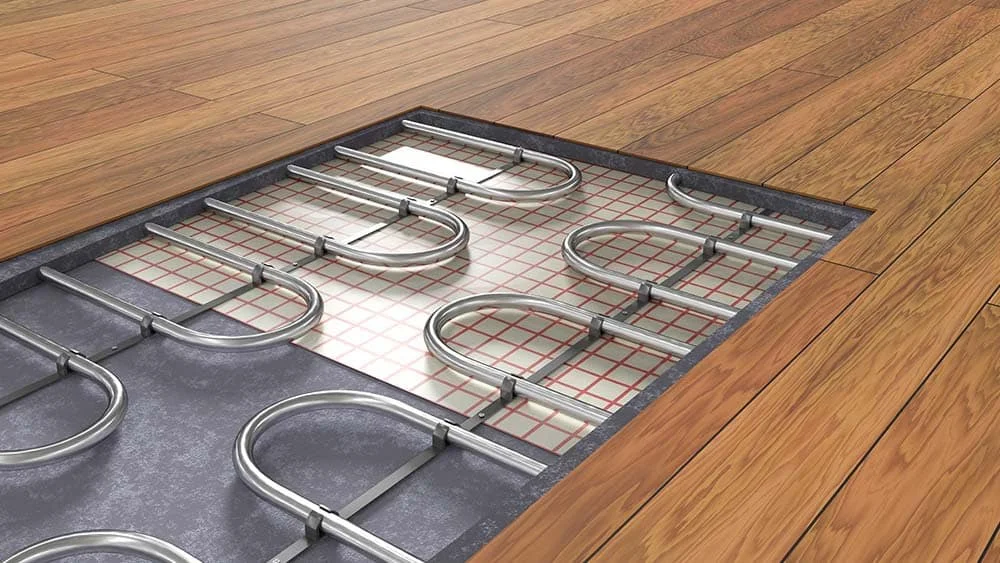
Key Takeaways
- Radiant floor heating evenly warms your home through the floor.
- This system offers consistent warmth and improved air quality.
- Radiant heating reduces circulation of dust, allergens, and pollutants.
Unlike traditional heating systems that rely on blowing hot air or radiating heat from a single source, radiant floor heating warms your home from the ground up, ensuring consistent and even warmth throughout the space. Just image the sensation of walking barefoot on a heated floor!
Also known as underfloor heating, this system is an energy-efficient way of keeping warm through the cold winter months. If you’re planning on renovating your house or are thinking of building a new one, installing radiant floor heating would be a great option to keep in mind.
What is Radiant Floor Heating?
Radiant floor heating systems work by transferring heat directly from heating elements, such as electric cables or hot water pipes, to the floor. The heat then rises naturally through convection, evenly warming your home and providing a comfortable living environment.
As compared to other traditional heating systems, radiant heating is not a direct form of heating. In the sense that it does not heat from a direct flame, neither does it blow hot air like a furnace. So, if you are someone who loves to huddle around a heater and get a cozy spot, you might find a radiant heating system just a bit different to your taste. Nevertheless, you may still love the consistent heat!
Related: Radiant Wall Heating – Why It’s The Perfect Solution
Types of Radiant Floor Heating Systems
Radiant floor heating comes in three types. Let’s have a closer look at all of them:
1. Electric Radiant Floor Heating
An electric radiant floor heating system consists of electric wires running under the floor surface. These electric wires heat up when electricity is passed through them. The heat then transfers through the floor and heats up the room. The thin heating wires are usually powered by a dedicated 15- or 20-amp electrical circuit and are controlled through a wall-mounted thermostat. They are easier to install compared to other types of radiant heated floors.
Running an electric underfloor heating can be costly because of high electricity prices. However, it can be more economical if you include a thermal mass, such as a thick concrete floor, which can retain heat for up to 10 hours without needing the heating to stay on. Another cost-saving option is using it in combination with a time-of-use rate plan from your utility company, allowing you to run the system during off-peak hours and rely on the stored heat during peak times.
2. Hydronic Radiant Floor Heating
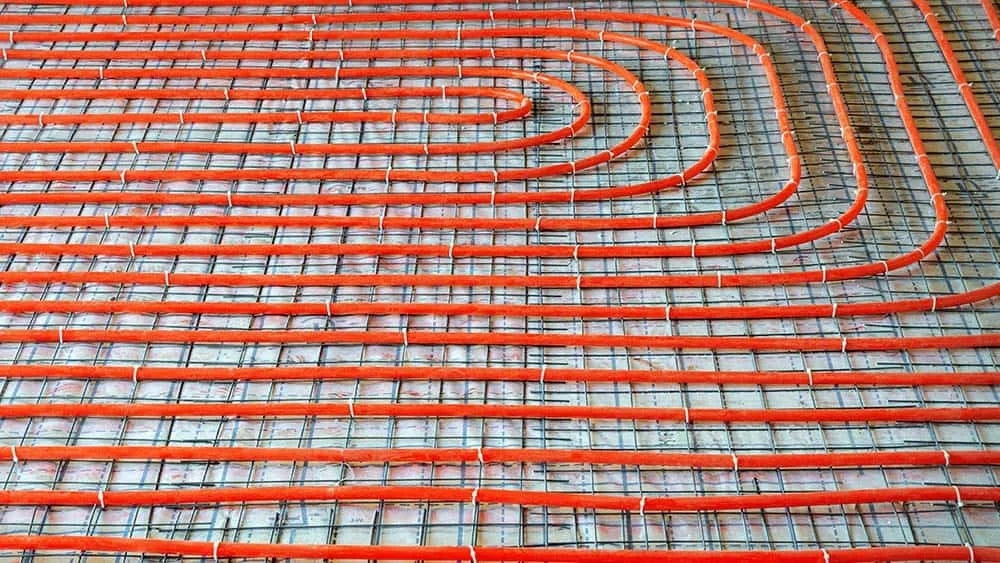
The other type of floor heating is done through hot water pipes embedded underneath the floor. This type of system is called a hydronic heating system. These pipes are connected to a hot water boiler and a pump, which circulates the hot water in this closed system.
Hydronic radiant floor heating is efficient and cost-effective for whole-house heating. While it can be added to an existing home, installing it during the construction process is much simpler. There are different methods for installing hydronic radiant floor heating. You can have it attached to aluminum strips on the underside of the floor or on top of the subfloor. Another option is to have it embedded in poured concrete. The installation method will vary depending on your budget, construction phase, and the type of flooring you are going for. For new construction, embedding the pipes in concrete is a preferred option. For retrofitting, installing the pipes either on the subfloor or between the joists is the preferred approach to accommodate architectural limitations.
3. Air-Heated Radiant Floors
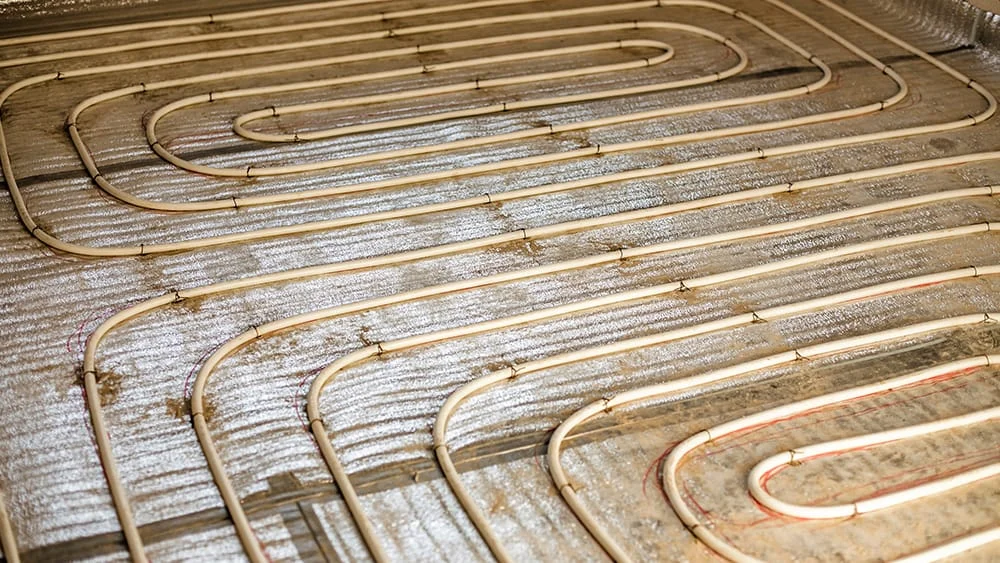
The third type of radiant floor heating, albeit a less common one, is air floor heating. As opposed to the other two types, air-heated flooring uses hot air channeled through the ducts embedded underneath the floor. A furnace heats the air and then circulates it through the piping networks, similar to how it is channeled through ducts in a ducted heating system. An alternative is to use solar air heaters, but the obvious disadvantage is that they can only be used during the day.
A drawback of air-heated radiant flooring is that air does not hold heat very well. It loses its temperature very quickly, necessitating the constant use of the furnace, which consumes more energy. Thus, this system is not a very efficient method.
Making Your Radiant Floor Heating Smart

Smart thermostats can work with underfloor heating systems, allowing you to control them through a smartphone app. Whether you’re at the office or out with family, adjusting the temperature is just a few taps away.
You can create schedules that automatically turn the heating on and off at specific times, ensuring your space is perfectly heated whenever you need it. For instance, you can set the heating to turn on an hour before you wake up in the morning so that you don’t have to wake up to a cold and chilly room.
With smart thermostats, you can also track your energy usage, making it easier to save on heating bills while maintaining comfort.
Equip your HVAC system with smart features and achieve the perfect balance between comfort & savings.
Learn more
Pros and Cons of Radiant Under-Floor Heating
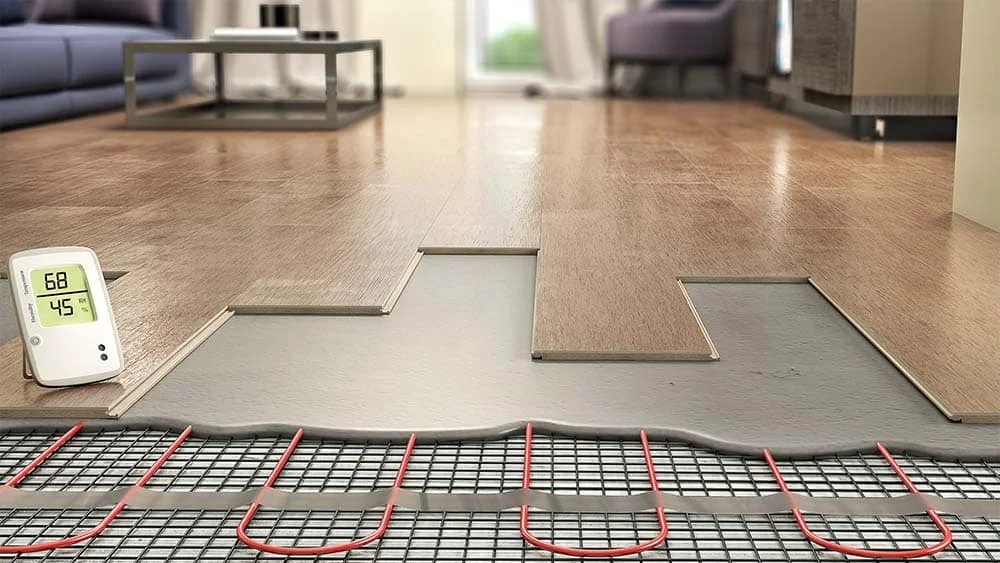
Let’s explore the advantages and disadvantages of radiant floor heating systems in detail.
Advantages of Radiant Floor Heating
- Radiant floor heating systems are much cheaper to operate than conventional heating systems, such as a furnace, heat pump, or radiator. The water in a radiator needs to be heated to a scorching 150 degrees, while with radiant heating systems, 85 degrees is more than enough to keep the room warm.
- These systems heat the home much more uniformly than forced-air systems. The heat rises from the floor and spreads evenly across the whole floor area, eliminating cold spots.
- In-floor radiant heating systems, especially hydronic ones, combine well with renewable energy options like solar water heaters or geothermal systems. This enhances energy efficiency and helps lower operating costs.
- The unobtrusive heating arrangement makes it pleasing to the eye. There are no indoor units, vents, or radiators sticking out of walls. Everything is hidden from view.
- Radiant floor heating systems are much safer to work with than other heating systems. They do not have electrical outlets, sharp edges, or hot surfaces.
- Radiant heated floors improve indoor air quality. Since they don’t use ducts or vents, dust, pollen, and other allergens can circulate less, making them a great choice for people with allergies.
- Your home humidity can be maintained at healthy levels since there is no dehumidifying effect, as is the case with forced air heating systems.
- They operate quietly compared to other heating options.
Related: Radiant Heat Vs. Forced Air – Which Is the Better Option?
Disadvantages of Radiant Floor Heating
- Radiant floor heating systems are comparatively difficult to set up in existing homes. The old floor would need to be torn apart, and a new floor would have to be laid over the underground heating system.
- Their installation costs can be pretty high.
- Hydronic system pipes can leak under the floor, causing water damage.
Important Points to Consider When Installing Radiant Floor Heating
Here are some factors to consider for optimal performance and efficiency:
-
Flooring Compatibility
Certain flooring materials are more conducive to radiant heat than others. Materials like ceramic tile, stone, and engineered wood are especially well-suited because they conduct heat efficiently, ensuring effective warmth distribution. Carpet and thick wood floors may reduce the system’s effectiveness.
Electric radiant system can be placed under various flooring materials, such as tiles, laminate, and certain types of vinyl, offering flexibility in design and use. Hydronic radiant floor heating is compatible with most finished flooring, such as hardwood and tile.
-
Installation Location
If you are building a new home or going for a major renovation, hydronic radiant floor heating is a great option to heat your entire home. It delivers consistent, comfortable warmth throughout the house without the need for visible radiators or ductwork.
Electric radiant floor heating is ideal for heating specific areas, such as warming a chilly bathroom floor or adding extra comfort to your home office.
Related: Bathroom Heating: All the Tricks Unlocked for a Toasty Bathroom
-
Adequate Insulation
Ensure that there is proper insulation beneath the heating elements to help direct the heat upward. This helps prevent heat from escaping from the downward side.
Radiant Floor Heating Cost

These systems generally tend to be a bit on the higher side of the cost scale. This is not only due to the expensive components but also due to the laborious installation process.
On average, installing radiant floor heating costs between $2000 and $6000. The exact price will vary depending on various factors:
- System Type – Hydronic systems usually cost more to install initially but are cheaper to operate over time compared to electric systems. Hydronic floor heating is around $19000-$48000. An electric radiant heating system is cheaper to install because it can be installed as a jigsaw puzzle, with ready-made mats able to be put in place. It costs between $19000-$36000. The operating cost for a hydronic radiant floor heating system is less than its electric counterpart. The reason for this is that water retains heat very well. Once the water is heated up, the boiler or water heater can turn off, and the water will still be hot for a considerable period. Hence the boiler/water heater needs to be operational for a lesser amount of time.
- Floor Size – Large areas require more materials and labor, increasing installation costs.
- Installation Complexity – The difficulty of installation can also impact the price of radiant heat flooring. Installing it in new construction will cost less as compared to retrofitting into existing home.
Is Underfloor Heating Worth It?

Radiant floor heating offers a modern, energy-efficient solution to your home heating needs. It provides consistent warmth, improves indoor air quality, and integrates seamlessly into your home’s design, making it a valuable addition to any space. While the upfront installation costs of radiant heated floors may be higher, the long-term savings on energy bills and enhanced comfort make it a worthwhile investment.




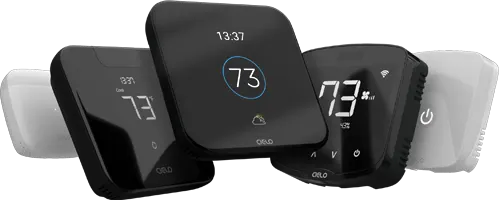

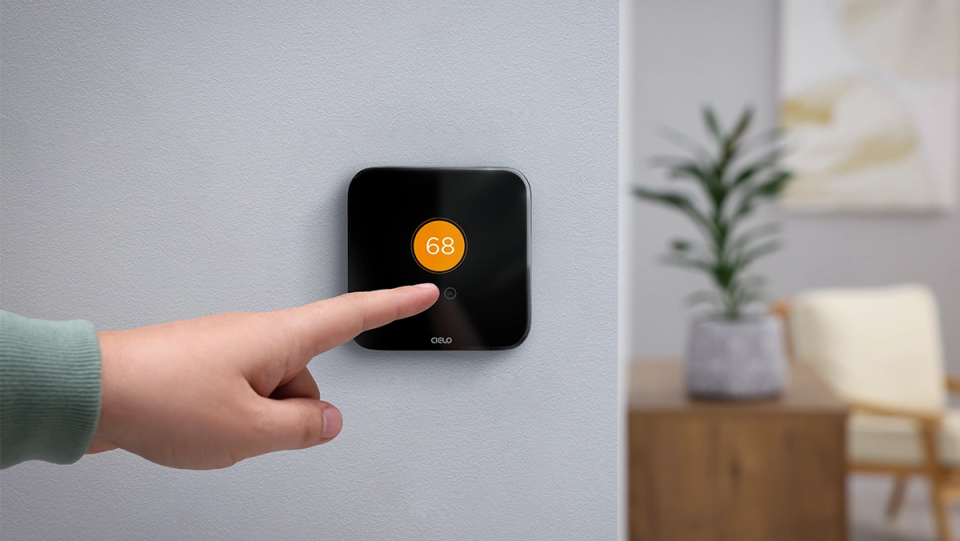


1 Comment. Leave new
We installed ultra-fin on the pex distribution system for radiant heating system. When it real cold we can not heat up the house. Example set temp of 70, cold weather in New York 0, the system can only reach 59. We must supplement with electric space heater.